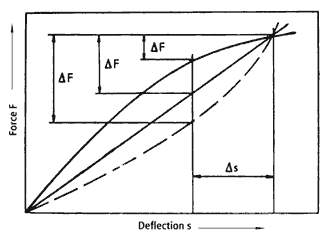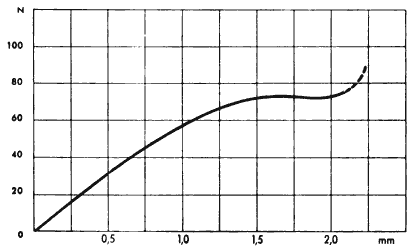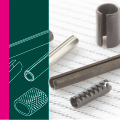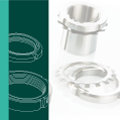Plain type (light print in the tables)
For many years, this company has been supplying CB-Ball Bearing Disc Springs with pronounced regressive characteristics (upper curve in Fig. 1 ) for backlash compensation, silencing and protection of ball bearings. This has the advantage that the pre-load variation changes very little within a wide range of deflection.
With coil springs or any other type of spring, a linear force/deflection characteristic is the best which could be achieved. (see middle curve Fig. 1).

Fig.1
Force deflection characteristics for different spring
CB-Ball Bearing Disc Spring
Theoretically linear spring
Spring with a progressive characteristic

Fig. 2
CB-Ball Bearning Disc Springs
a) Plain type
b) Slotted type
Fig. 1 clearly shows that the force difference (ΔF), at a given deflection range (Δs), is substantially greater in a linear characteristic than with the pronounced regressive characteristic of cb-Ball Bearing Disc Springs, which have been specially designed for ball bearings.
The advantages of cb-Ball Bearing Disc Springs become even more evident when compared with the characteristics of backlash compensating springs with progressive curves. Here, any deflection variation (Δs) will inevitably result in a significant increase or decrease in the applied force (see broken curve in Fig. 1).
Slotted type (bold print in the tables)
Bal bearing disc springs with very low force characteristics and very large deflection are increasingly required for use with small size ball bearings. To meet this requirement a series of slotted cb-Ball Bearing Disc Springs (Fig. 2) have been developed which, compared with the plain type, are particularly low force and allow a very large amount of deflection . This ensures a very small variation of load (ΔF) within deflection range (Δs).

Fig. 3.3
Measured characteristic of slotted
CB-Ball Bearning Disc Spring for bearing 6306,
71,5x45,5x0,60 Io=2,90 mm
Force Multiplication by Stacking
Where the spring forces stated in the tables are too low, cb-Ball Bearing Disc Springs can of course be used two or more in parallel, which results in the force being increased by the corresponding factor of two or more.

Fig. 3.1 Three-phase asynchronous motor with slotted CB-Ball Bearing Disc Spring (ATB, Welzheim)
Damping
Hysteresis, a measure of damping, increases in proportion to the number of springs stacked in parallel. Vibration, which may damage the bearing contact surfaces, can therefore be damped by multiple disc stacking in parallel.
Materials
CB-Ball Bearing Disc Springs are manufactured from high-quality spring steel; they can also be made to order in other materials e.g. corrosion resistant or non-magnetic steel, spring bronze Cu Sn 8, copper beryllium alloy Cu Be 2, Nimonic 90 and others.
If you contemplate using one of these materials please let us know your exact requirements. In many cases materials other than normal spring steel have different values for elastic modulus and allowable design stress. Therefore, the disc spring design may have to be recalculated with different spring thickness and possibly different spring deflection.

Fig. 3.2 Cut-away view of a motor fitted with bearing 6306 and cb-Ball Bearing Disc Spring




















